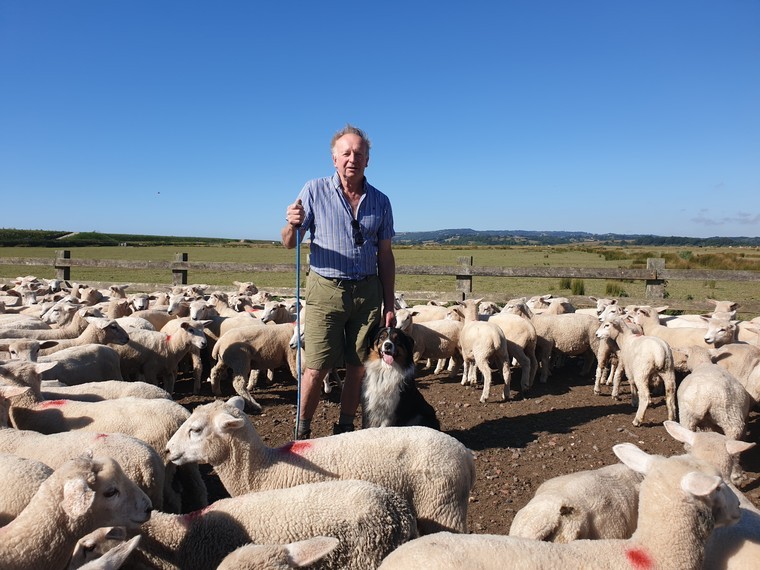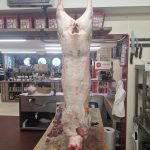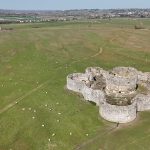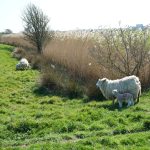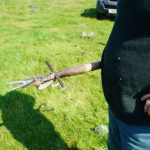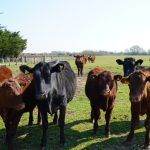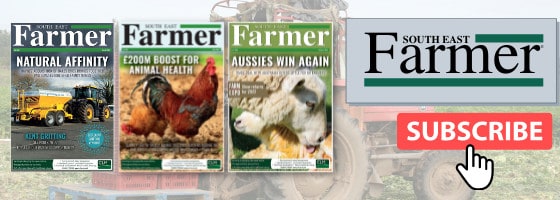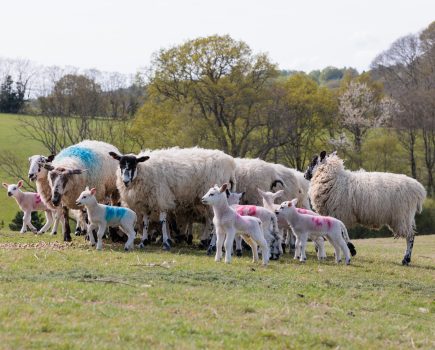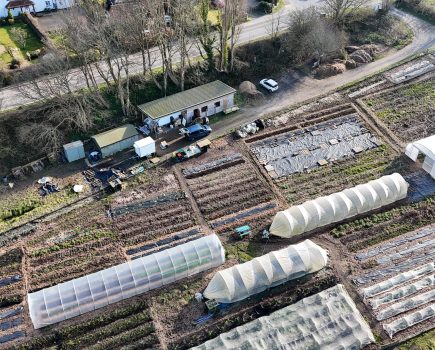This month Nigel Akehurst visited Langrish Farmers at Castle Farm in Winchelsea, East Sussex. He met up with Frank Langrish to learn more about the low-input sheep and cattle family farming enterprise, as well as an innovative new project to improve the profitability of wool.
As soon as I stepped out of the car at Castle Farm, the salty sea breeze hit me; a clear reminder of just how close the farm is to Winchelsea Beach and Rye Harbour Nature Reserve.
The farmyard was bustling with activity, a young woman energetically pressure-washing a livestock trailer while another team member prepared a Valtra tractor, complete with power harrow and drill, for the day’s fieldwork. Nearby, a smart blue livestock lorry, proudly branded “Langrish Farmers”, caught my attention, parked neatly in one of the larger barns.
With a little time to spare before meeting Frank Langrish, I launched my drone for some aerial shots. Instantly, I was struck by the majestic sight of the 16th-century Camber Castle nestled within the farm boundaries. Built by King Henry VIII and now managed by English Heritage, the castle provided an impressive backdrop to one of the farm’s main lambing fields.
A Legacy of three generations
Soon enough, Frank pulled up in his well-used pickup truck. Offering a hearty handshake, he warmly suggested we take a drive around the farm to understand its scale and operations better. As we drove through lush fields rich with grass and vibrant clover, Frank began recounting the Langrish family’s long farming history.
“It’s changed a lot since my grandfather’s time,” Frank remarked thoughtfully. His grandfather Frederick began farming in Beckley back in 1914 with just 50 acres, managing cows, sheep, and pigs. “It was a modest start,” Frank added, “but he laid the foundation for everything we have today.”
Frank’s father Bob expanded the business considerably in the late 1930s, gradually moving away from pigs to concentrate on hardy local breeds of sheep and cattle. A significant step was acquiring Castle Farm’s 350 acres in 1978, alongside an additional 400-acre block at nearby Pett Level. “My father was a visionary,” Frank explained with pride. “He could always see potential where others couldn’t.”
Frank and his late brother Robert joined the family business and continued expanding it to its current size of around 700 hectares, a mix of owned and rented land. “At our peak, we managed about 5,000 breeding ewes,” Frank said, “though these days we’ve scaled back slightly to around 4,000, mainly Romneys. We’ve also got about 400 cattle, including a pedigree herd of 55 Sussex cows.”
Today the team comprises Frank, his son Ed, the fourth generation, who joined him in the business in 2010, Frank’s wife Celia and Ed’s wife Verity, who both provide valuable admin back-up. They are supported by a team of four part-time and full-time staff.
Sustainable farming philosophy
As we drove on, Frank passionately described the business’ sustainable, grass-fed farming philosophy. “Everything raised here is 100% grass-fed,” he explained – a principle deeply rooted in his family’s farming tradition. He recalled one of his father’s favourite sayings: “Patience is cheaper than a bag,” referencing the cost-effectiveness and ecological benefits of avoiding expensive bought-in feeds and fertilisers.
“Our soil does the hard work,” Frank explained. “Most of our land is grade 1 or 2, deep alluvial soil rich in nutrients, and the clover naturally fixes nitrogen.” This low-input approach hasn’t just benefited farm economics; it has significantly boosted local wildlife, with much of their grazing land in Higher Level Stewardship and being designated as a Site of Special Scientific Interest, a Special Protection Area and a Ramsar site.
In addition, the business also manages several outlying blocks of land, such as Hastings Country Park Nature Reserve in Fairlight, carrying out conservation grazing practices and demonstrating a commitment to environmental sustainability.
Efficient lambing and livestock management
We soon arrived at the lambing fields, where Frank detailed the streamlined outdoor lambing system. “Simplicity and efficiency are key,” he noted.
Ewes are maintained on tight, poorer-quality grazing, encouraging easy lambing. They receive minimal intervention and are checked just three times daily. “The ewes winter off-farm, often in the West Country or in Norfolk,” Frank explained, “returning about two weeks before lambing to be scanned and grouped into singles, twins, or triplets.”
Their flock, predominantly Romneys improved with New Zealand genetics, regularly achieves strong lambing percentages. Frank and the partners breed their own replacements and each year approximately 1,000 lambs supply local butchers and wholesalers, with the remainder sold at markets in Ashford and Hailsham either fat or as stores.
Frank emphasised: “Quality and consistency are essential. We’ve built good relationships locally because of that.”
Innovating with British wool: the Snowline UK sheep project
When we moved onto wool production, Frank’s eyes lit up, reflecting his deep passion and continued involvement with the British Wool Board (Frank was chairman from 1999 to 2011). He shared a striking anecdote: “In 2019, it cost me £16,000 to shear our sheep, yet we only made £5,000 back from wool sales. That was my wake-up call.”
Determined to improve wool profitability, Frank discovered Snowline sheep during a world-record sheep-shearing event involving Megan Whitehead, a renowned New Zealand shearer. “Watching Megan shear these Snowlines on Facebook,” Frank remembered vividly, “I was amazed by the beautiful fine wool. I knew immediately this was something special.”
Curious to learn more, Frank contacted John McDonald, the owner of Snowlines in New Zealand. Despite initial challenges, including significant import and quarantine hurdles exacerbated by the Covid pandemic, Frank successfully imported Snowline genetics.
“The effort and cost was immense,” he said, “but I’m hopeful I’ll get my money back. I didn’t want to go down the ‘no wool’ route and I couldn’t see any other way of making it work.”
Snowline wool, valued for its fineness (below 28 microns), commands a significantly higher price than standard wool. A kilo of 24-micron wool is worth four times as much as a kilo of above 30 micron wool as it is no longer ‘scratchy’ against the skin.
With a £45,000 DEFRA Innovation UK grant, Frank launched the Fabulous Fibre feasibility project in 2024, aiming to enhance UK wool through selective breeding and micron testing. He’s also actively pursuing funding to import handheld micron-testing devices, a technology that could revolutionise wool sorting and marketing.
“We have the potential to really change things here,” Frank emphasised, clearly excited about the possibilities.
Frank took me to see a group of his young Snowline rams, which we penned to take a closer look. Putting my hand on their fleece I could clearly feel the difference between the Snowline rams and the pure Romneys; the wool was much softer to the touch and they also looked cleaner than the Romneys. Frank pointed out how long bodied they are, remarking: “Length always equals weight, so the wool is a bonus.”
He added: “The McDonalds have been breeding them for 40 years and on their system, lambing outside un-shepherded, they are getting 150-160%, which is pretty good. I’d be happy to get that on my shepherded ones.”
The next step is reaching a critical mass, he said. He’s hoping to get together with the other Snowline UK sheep breeders in the UK to sell the wool collectively under the Snowline UK brand, to which he owns the licence. He said they were already working with the Peregrine knitting company in Bristol and had other large brands interested.
Economic and supply chain challenges facing British farmers
Our conversation turned candidly to economic challenges, including cuts to Basic Payment Scheme payments and looming concerns about inheritance tax. Frank expressed frustration, noting that such financial pressures significantly impacted farm investment decisions.
“It’s forcing us to rethink everything,” he admitted, “We’re now carefully restructuring our farm partnerships to mitigate future impacts.”
We stopped at Ship Farm Shop in Winchelsea for coffee and a chat with Jamie, the shop’s butcher. Jamie raised concerns about rapidly rising beef prices, reflecting broader market volatility. Frank agreed, observing: “It’s been a swift correction, but the speed has taken everyone by surprise and has largely been driven by the demand for mince, which has nearly doubled in less than a year.”
Frank also touched on broader market conditions. “This autumn, I suspect we’ll see several farm sales as more farmers decide to retire rather than struggle through another tough year,” he surmised.
Despite these challenges, Frank remains actively engaged in policy advocacy, mentioning an upcoming visit from his local MP to discuss critical farming issues. “We need supportive policies,” he asserted firmly, “or the future of British farming could look quite bleak.”
On the topic of local abattoirs, Frank said more needed to be done to stop any further closures and he’s keen to find funding for a feasibility study into opening one or even two new purpose-built facilities in the South East, to boost capacity.
Advice and outlook for new farmers
As we headed back towards the farmyard, Frank offered candid advice for new entrants into farming. “Honestly, unless you’ve got significant financial backing or secure tenure of land, it’s incredibly challenging to start farming today,” he said bluntly. “Banks aren’t lending readily, input costs are rising and land prices are prohibitive.”
He suggested gaining experience first-hand instead: “There’s plenty of day work available. It’s a great way to learn the ropes without the enormous financial risk.” Yet despite these practical warnings, Frank remains cautiously optimistic about the future. “Farmers are resilient,” he reminded me, smiling warmly. “We’ve weathered worse storms before. With the right support and innovation, I genuinely believe we can create a sustainable and profitable future.”
As we shook hands and said goodbye, Frank’s parting words resonated strongly: “We need forward-thinking policies and better incentives for young farmers. If we can achieve that, British farming has a bright future ahead.”
Farm facts
- 700 hectares of owned and rented land
- Low-input, wildlife-friendly farming practices
- 4,000 breeding ewes (mainly Romney), outdoor easy lambing system
- 400 head of cattle including a herd of 55 Pedigree Sussex
- Operates its own livestock lorry and trailer, carrying out haulage for other farmers
- Higher Level Stewardship agreement
- Much of the grazing land is designated Site of Special Scientific Interest, a Special Protection Area and a Ramsar site
- Snowline UK sheep project aims to improve the quality and value of wool
- Four partners in the business plus a small team of part and full-time staff
- Supplies local butchers and wholesalers with beef and lamb
For more like this, sign up for the FREE South East Farmer e-newsletter here and receive all the latest farming news, reviews and insight straight to your inbox.

